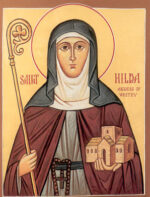
According to St. Bede, St. Hilda was born in 614 into the Deiran royal household. She was the second daughter of Hereric, nephew of Edwin, King of Deira and his wife, Breguswīþ.When Hilda was still an infant, her father was poisoned while in exile at the court of the Brittonic king of Elmet in what is now West Yorkshire. In 616, Edwin killed Aethefrith, the son of Æthelric of Bernicia, in battle. He created the Kingdom of Northumbria and took its throne. Hilda was brought up at King Edwin’s court.
In 627 King Edwin was baptised on Easter Day, 12 April, along with his entire court, which included the 13-year-old Hilda, in a small wooden church hastily constructed for the occasion near the site of the present York Minster. In 633 Northumbria was overrun by the neighbouring pagan King of Mercia, at which time King Edwin fell in battle. Paulinus accompanied Hilda and Queen Æthelburh and her companions to the Queen’s home in Kent. Queen Æthelburh founded a convent at Lyminge and it is assumed that Hilda remained with the Queen-Abbess.
At the age of 33, Hilda decided to answer the call of Bishop Aidan of Lindisfarne and returned to Northumbria to live as a nun. Hilda’s original convent is not known except that it was on the north bank of the River Wear. Here, with a few companions, she learned the traditions of Celtic monasticism, which Bishop Aidan brought from Iona. After a year Aidan appointed Hilda as the second Abbess of Hartlepool Abbey. No trace remains of this abbey, but its monastic cemetery has been found near the present St Hilda’s Church, Hartlepool.
In 657 Hilda became the founding abbess of Whitby Abbey, then known as Streoneshalh; she remained there until her death. Archaeological evidence shows that her monastery was in the Celtic style, with its members living in small houses, each for two or three people. The tradition in double monasteries, such as Hartlepool and Whitby, was that men and women lived separately but worshipped together in church.
St. Bede states that the original ideals of monasticism were maintained strictly in Hilda’s abbey. All property and goods were held in common; Christian virtues were exercised, especially peace and charity. Everyone had to study the Bible and do good works. Five men from this monastery later became bishops. Two, John of Beverley, Bishop of Hexham and Wilfrid, Bishop of York, were canonized for their service to the Christian church at a critical period in its fight against paganism.
Bede describes Hilda as a woman of great energy, who was a skilled administrator and teacher. As a landowner she had many in her employ to care for sheep and cattle, farming, and woodcutting. She gained such a reputation for wisdom that kings and princes sought her advice. However, she also had a concern for ordinary folk such as Cædmon . He was a herder at the monastery, who was inspired in a dream to sing verses in praise of God. Hilda recognized his gift and encouraged him to develop it. Bede writes, “All who knew her called her mother because of her outstanding devotion and grace.”
Hilda suffered from a fever for the last seven years of her life, but she continued to work until her death on 17 November 680 AD, at what was then the advanced age of sixty-six. In her last year she set up another monastery, fourteen miles from Whitby, at Hackness. She died after receiving viaticum, and her legend holds that at the moment of her death the bells of the monastery of Hackness tolled. A nun there named Begu claimed to have witnessed Hilda’s soul being borne to heaven by angels.
The veneration of St. Hilda from an early period is attested by the inclusion of her name in the calendar of St. Willibrord, written at the beginning of the 8th century. According to one tradition, her relics were translated to Glastonbury by King Edmund; another tradition holds that St. Edmund brought her relics to Gloucester. In the Roman Catholic Church, the feast day of St. Hilda is 17 November. In some parts of the Anglican Communion, her feast is on 18 November, while in some others, such as the Anglican Church of Australia and the Anglican Church of Canada, it is on 17 November. In the Church of England however, it is kept on 19 November.
Hilda is considered one of the patron saints of learning and culture, including poetry, due to her patronage of Cædmon. A local legend says that when sea birds fly over the abbey they dip their wings in honour of Saint Hilda. Another legend tells of a plague of snakes which Hilda turned to stone, supposedly explaining the presence of ammonite fossils on the shore; heads were carved onto these ‘petrified snakes’ to honour this legend.
